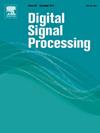Interrupted sampling repeater jamming suppression based on Gaussian mixture model and sparse reconstruction
IF 2.9
3区 工程技术
Q2 ENGINEERING, ELECTRICAL & ELECTRONIC
引用次数: 0
Abstract
The interrupted sampling repeater jamming (ISRJ) based on digital radio frequency memory (DRFM) is coherent with the radar transmitted signal, allowing it to obtain partial pulse compression gain while exhibiting both suppression and deception jamming effects, posing a significant threat to modern radars. In this article, we propose an ISRJ suppression method based on Gaussian Mixture Model (GMM) and sparse reconstruction. Firstly, the probability distribution of the amplitudes of the received echoes is fitted using a GMM to obtain the mean value of each component. Based on the magnitude and the discontinuous nature of ISRJ in the time domain, jamming-free signal segments are extracted. Subsequently, these segments are processed through de-chirping, and by leveraging their sparse characteristics in the frequency domain, the complete target echo is obtained through sparse reconstruction. Matching filtering is then applied to the reconstructed target echo, followed by peak searching, to detect the genuine target echo, thereby achieving ISRJ suppression. Experimental results demonstrate that this method exhibits high accuracy in extracting the jamming-free signal segments and excellent ISRJ suppression performance, while also demonstrating strong robustness against different jamming parameters.

求助全文
约1分钟内获得全文
求助全文
来源期刊

Digital Signal Processing
工程技术-工程:电子与电气
CiteScore
5.30
自引率
17.20%
发文量
435
审稿时长
66 days
期刊介绍:
Digital Signal Processing: A Review Journal is one of the oldest and most established journals in the field of signal processing yet it aims to be the most innovative. The Journal invites top quality research articles at the frontiers of research in all aspects of signal processing. Our objective is to provide a platform for the publication of ground-breaking research in signal processing with both academic and industrial appeal.
The journal has a special emphasis on statistical signal processing methodology such as Bayesian signal processing, and encourages articles on emerging applications of signal processing such as:
• big data• machine learning• internet of things• information security• systems biology and computational biology,• financial time series analysis,• autonomous vehicles,• quantum computing,• neuromorphic engineering,• human-computer interaction and intelligent user interfaces,• environmental signal processing,• geophysical signal processing including seismic signal processing,• chemioinformatics and bioinformatics,• audio, visual and performance arts,• disaster management and prevention,• renewable energy,
 求助内容:
求助内容: 应助结果提醒方式:
应助结果提醒方式:


